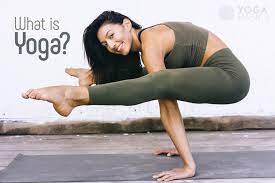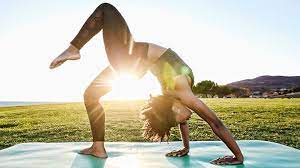Boost Your Mental and Physical Wellness with Yoga
Yoga is an ancient practice that has gained popularity all over the world for its numerous health benefits. It involves the integration of physical postures, breathing techniques, and meditation to promote holistic well-being. Practicing yoga on a regular basis can have significant positive effects on both mental and physical health, reducing stress levels, improving flexibility and balance, and boosting immunity. In this blog post, we’ll explore how yoga can help you achieve a happy and healthy life, both physically and mentally. So, roll out your yoga mat and let’s get started!
What is Yoga?
The Physical Benefits of Yoga
The Mental Benefits of Yoga
Different Types of Yoga Practices
Tips for Starting Your Own Yoga Practice
Incorporating Yoga into Your Daily Life
What is Yoga?

Yoga is a mind and body practice that has been around for thousands of years. It originated in India as a way to achieve a peaceful mind and a healthy body. The practice of yoga is all about finding balance, harmony, and unity within oneself.
At its core, yoga combines physical postures (asanas), breathing exercises (pranayama), and meditation to improve overall health and well-being. It can help with stress relief, increase flexibility, improve balance, build strength, and promote mindfulness.
Yoga is not just about stretching or contorting your body into difficult poses. Instead, it is a practice that emphasizes awareness of one’s body, breath, and mind. It encourages a deep connection with oneself, allowing individuals to find inner peace and self-awareness.
In essence, yoga is a holistic practice that brings together the mind, body, and spirit. Its benefits are countless, and anyone can practice yoga, regardless of their age, gender, or fitness level. So, whether you’re looking to improve your physical health, reduce stress and anxiety, or find inner peace, yoga may be the perfect solution.
The Physical Benefits of Yoga
Apart from its calming effects, practicing yoga is also beneficial for your physical health. Here are some of the physical benefits of yoga that you can enjoy:
- Increases Flexibility: Yoga postures or asanas help to increase your body’s flexibility and range of motion. With regular practice, you’ll find that your muscles become more flexible and supple, which can help reduce the risk of injuries.
- Strengthens Muscles: Yoga also helps to tone and strengthen your muscles. The various asanas target different muscles in your body, helping to improve your overall muscle strength and endurance.
- Improves Posture: Sitting in front of a computer for extended periods can lead to poor posture, which can cause neck and back pain. Yoga helps to improve your posture by aligning your spine and improving your core strength.
- Boosts Cardiovascular Health: Certain types of yoga, such as Vinyasa and Power yoga, involve continuous movement, which can help to improve your heart health and lower your risk of cardiovascular disease.
- Reduces Inflammation: Chronic inflammation can lead to a variety of health problems, including arthritis and heart disease. Yoga has been shown to help reduce inflammation in the body, which can improve your overall health and well-being.
- Helps with Weight Loss: Regular practice of yoga can also help with weight loss. The various asanas help to burn calories and build muscle, which can lead to a reduction in body fat.
Incorporating yoga into your daily routine can have numerous physical benefits. So, why not give it a try? Whether you choose to attend a yoga class or practice at home, you’ll soon start to see the positive changes in your body and overall health.
The Mental Benefits of Yoga

Yoga is not only a physical exercise but also a mind-body practice that offers numerous mental health benefits. In fact, many people turn to yoga to find inner peace and mental balance.
One of the most significant mental benefits of yoga is that it helps to reduce stress and anxiety levels. Practicing yoga poses, breathing techniques, and meditation can all contribute to creating a calm and peaceful mind. Studies have shown that yoga can lower cortisol levels in the body, which is the hormone responsible for stress.
Furthermore, practicing yoga can help to boost your mood and combat depression. Regular yoga practice has been linked to the increased production of neurotransmitters such as dopamine and serotonin, which can help to lift your mood and improve overall emotional wellbeing.
In addition, yoga can improve cognitive function and focus. The combination of breathing techniques, meditation, and physical movement can help to sharpen your mental clarity and increase your ability to concentrate.
Moreover, yoga promotes self-awareness and mindfulness, which can help to enhance your overall quality of life. By focusing on the present moment and being aware of your thoughts and feelings, you can learn to respond to life’s challenges in a more calm and centered manner.
Overall, the mental benefits of yoga are just as important as the physical benefits. Yoga can help you to find inner peace, manage stress, improve mood, and increase focus and awareness. So, if you’re looking for a holistic way to improve your mental health and wellbeing, practicing yoga may be the answer.
Different Types of Yoga Practices
Yoga is a practice that has evolved over thousands of years, and there are many different types of yoga that cater to different physical and mental needs. Some of the most popular types of yoga include:
- Hatha Yoga: This is a slow-paced, gentle practice that is perfect for beginners. It focuses on breathing and basic poses that improve flexibility, strength, and balance.
- Vinyasa Yoga: This practice is more fast-paced and challenging than Hatha yoga. It involves flowing movements that synchronize with breath and increase heart rate. Vinyasa yoga builds strength, flexibility, and endurance.
- Ashtanga Yoga: Ashtanga is a rigorous, physically demanding practice that follows a set sequence of poses. It focuses on building strength, endurance, and flexibility, and is great for those looking for a challenge.
- Restorative Yoga: This practice is all about relaxation and restoration. It involves gentle poses that are held for longer periods of time, allowing the body to relax and release tension.
- Kundalini Yoga: Kundalini yoga involves dynamic movements, breathwork, and meditation. It aims to release energy from the lower spine and move it upward through the body, promoting a sense of vitality and clarity.
Each type of yoga has its own benefits and appeals to different practitioners. It’s important to try out different styles and find one that works for you. Remember that there is no right or wrong way to practice yoga – it’s all about finding what feels good for your body and mind.
Tips for Starting Your Own Yoga Practice

If you’re new to yoga or want to start your own practice at home, here are some tips to get you started:
- Start small: Don’t jump into an hour-long practice right away. Begin with just a few poses or a short guided meditation to build up your stamina.
- Create a routine: Pick a specific time each day that works best for you to practice and make it a habit.
- Find a space: Create a comfortable space in your home where you can practice without distraction.
- Invest in good equipment: Buy a high-quality mat and comfortable clothes that allow you to move freely.
- Learn the basics: Attend a few classes or watch instructional videos to learn the proper alignment and techniques for each pose.
- Listen to your body: Be gentle with yourself and take breaks when you need them. Pushing yourself too hard can lead to injury.
- Don’t compare yourself to others: Everyone’s practice is unique. Don’t feel discouraged if you can’t do a certain pose right away.
Remember, the most important part of yoga is to listen to your body and be patient with yourself. With time and practice, you will start to notice the physical and mental benefits that come with a consistent yoga practice.
Incorporating Yoga into Your Daily Life

If you’re convinced of the many benefits of yoga and ready to give it a try, the next step is figuring out how to incorporate it into your daily routine. Here are a few tips to get you started:
- Start small: If you’re new to yoga, don’t try to take on a full hour-long class right away. Begin with a 15-minute practice and gradually build up as you become more comfortable.
- Find a routine that works for you: Whether it’s first thing in the morning, during your lunch break, or in the evening before bed, find a time that works best for your schedule and stick with it.
- Create a dedicated space: Set up a designated space in your home for your yoga practice. It doesn’t have to be a full-on yoga studio, just a quiet and comfortable spot where you can roll out your mat and practice without any distractions.
- Use apps or online resources: If you don’t have the time or resources to attend a class in-person, there are many great yoga apps and online resources that offer guided practices.
- Practice mindfulness throughout the day: Yoga isn’t just something you do on the mat. Bring mindfulness into your daily life by focusing on your breath and posture throughout the day.
Incorporating yoga into your daily routine may seem challenging at first, but with patience and consistency, it will become a natural part of your life. The mental and physical benefits of this ancient practice are worth the effort and will help you achieve a happier and healthier life.

